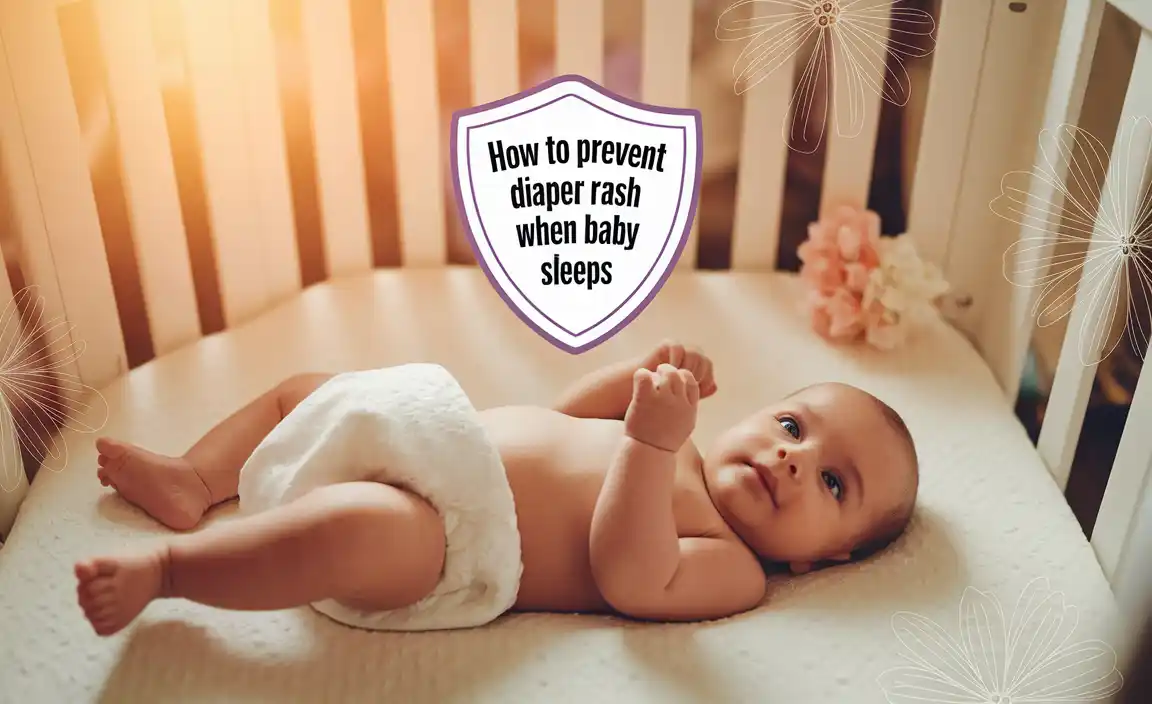A diaper rash is a common skin condition when a baby’s skin becomes irritated by contact with the material used to diaper them. The most common cause of diaper rash is excessive moisture or exposure to bacteria in the diaper.
It is common for babies to get diaper rash, but it’s not inevitable. With some attention and care, it’s possible to prevent diaper rash from happening in the first place. Diaper rash is one of the most common and frustrating problems new parents face.
Diaper rash is uncomfortable for your baby and can also cause distress to you. But don’t worry; preventing diaper rash when your baby sleeps is simple. We’ll list six tips to keep your baby’s skin rash-free. We’ll also explore why babies get diaper rash, the benefits of using a diaper rash cream, and whether it matters which formula you use for your baby’s rash cream.

6 Ways To Prevent Diaper Rash When Baby Sleeps
Diaper rash is a common problem faced by most parents. To prevent diaper rash when the baby sleeps, here are 6 ways to help: Firstly, changing the diaper every 2 hours is important. This keeps the baby’s skin dry and reduces the risk of diaper rash.
Avoid using products that contain fragrances or alcohol, as they can irritate. Some parents find that using cloth diapers or trying different types of diapers can help prevent diaper rash. Next, clean the baby’s bottom using cotton balls or a washcloth soaked in warm water.
This avoids irritation from wipes that may contain harsh chemicals. An ointment or cream can also be used before bedtime to form a protective barrier and keep the baby’s skin moisturized. By following these simple steps, parents can help prevent diaper rash and keep their babies comfortable while they sleep.
1. Monitor Your Baby’s Skin
It is important to monitor your baby’s skin properly. A few issues to look out for include red, itchy, or blotchy skin; a rash that doesn’t seem to be improving or getting worse; or a rash that occurs on the genital area or buttocks.
It can be difficult to tell if your baby’s diaper rash is caused by a specific factor, such as detergent or fabric softener, so it is important to take a holistic approach and watch for other signs of irritation, such as redness, itching,
or a rash that doesn’t seem to be improving. If you notice any of these issues, consider consulting your pediatrician for advice on treating the diaper rash. You can also take steps to monitor your baby’s skin and see if any of these issues resolve on their own.
2. Change Diapers Regularly
Preventing diaper rash is essential to keep your baby comfortable throughout the night. Regular diaper changes are crucial in reducing the risk of diaper rash when your baby sleeps.
Changing your baby’s diapers about every two hours is recommended, even if they’re sound asleep. During diaper changes, clean your baby’s bottom with warm water and cotton balls or a washcloth.
It’s also important to check your baby’s diaper every few hours to ensure they’re not too wet. Avoid using perfumes, alcohol, and scented baby wipes that can irritate your baby’s delicate skin.
Try experimenting with different types of diapers to prevent diaper rash. Some babies may be more comfortable in cloth diapers, while others prefer disposable ones. With these simple tips, it’s possible to help prevent diaper rash and keep your baby comfortable as they sleep.
3. Keep It Clean And Dry
To prevent diaper rash when a baby sleeps, there are several steps that parents can take. Keeping the area clean and dry is crucial. To achieve this, parents should change diapers often and immediately after they become wet or soiled.
Secure the diaper loosely to promote airflow and avoid the adhesive tabs sticking to the baby’s skin. It’s also important to wash hands before and after changing a diaper to prevent the spread of germs. Using a barrier ointment or cream with each diaper change is another useful step to prevent irritation.
These creams create a protective barrier between the skin and the diaper. Zinc oxide-based creams are particularly effective in treating rashes that won’t clear up. These steps can help parents prevent diaper rash when a baby sleeps and ensure their baby stays comfortable and healthy.
4. Choose The Right Size Of Diaper
Preventing diaper rash is crucial for your baby’s comfort and health, especially when they sleep. Here are six ways to prevent diaper rash when your baby sleeps: First and foremost, be sure to choose the right size of diaper that fits your baby’s weight.
Using a too tight or loose diaper can increase the risk of diaper rash. Change your baby’s diaper right before bedtime and before nighttime feedings, if possible, to provide the most protection during sleep. When putting on a new diaper,
check the size for a proper fit and adjust accordingly. Also, consider switching to cloth diapers if disposable diapers are not providing enough protection. Following these tips can help prevent diaper rash and keep your baby comfortable and happy while they sleep.
5. Use A Barrier Cream Or Ointment
A barrier cream or ointment is one effective way to prevent diaper rash when your baby sleeps. Before putting your baby to bed, apply thick barrier ointment or cream on the diaper area. Popular and well-trusted options include Vaseline, Aquaphor,
Vanicream, and Cerave ointment. If your baby has an active diaper rash, consider using a zinc oxide-based cream or ointment for added relief. Additionally, it’s important to change your baby’s diapers as soon as you notice they are dirty and to use a protective ointment like Vaseline or Desitin to form a barrier between the skin and the stool. By taking these steps, you can help prevent diaper rash and ensure your baby gets a good night’s sleep.
6. Avoid Fragranced Products
Avoid using fragranced products such as diaper ointments, wipes, creams, and lotions on your baby since they can cause diaper rash. These products contain ingredients that can irritate sensitive skin. Also, avoid using synthetic fabric softeners (such as Downy) or soap substitutes on your baby’s diapers since they may also irritate.
Finally, avoid using diapers with extra absorbent layers since these can trap moisture and lead to more diaper rash. In addition, avoid using paper diapers for long-term use since they irritate diapers. Instead, use cloth or disposable diapers made from gentle materials on the skin.
Soap is another common culprit behind diaper rash in babies – avoid washing your baby’s dirty diapers in soaps or detergents that contain strong odors or scents like lemon or floral fragrances, as these may damage your baby’s delicate skin.
Avoid contact with other people’s dirty laundry, too – you don’t want to inadvertently pass on bacteria that has landed on your baby’s skin to someone else’s child. A little caution goes a long way when preventing diaper rash in your new bundle of joy.
Why Do Babies Get Diaper Rash?
Diaper rash is a universal concern among parents with newborns. Several factors, including bacterial and fungal infections, allergies or irritations, sensitive skin, prolonged exposure to wet diapers, and new foods, can cause diaper rash in babies.
Babies urinate frequently, and urine changes the skin’s pH level, making it more susceptible to bacterial and fungal infections, resulting in diaper rash. Similarly, diapers kept for too long can lead to irritation and rashes.
Sensitive skin can also react to chemicals like detergent, soap, diapers, or baby wipes, causing diaper rash. To prevent diaper rash, ensure frequent changes, avoid using fragranced products, and apply a diaper rash cream or ointment to the affected area.
What Are The Benefits Of Using A Diaper Rash Cream?
There are many benefits of using a diaper rash cream. One of the benefits is that it can help prevent diaper rash and other skin irritations caused by irritating chemicals in disposable diapers.
A diaper rash cream contains ingredients that moisturize the skin and help treat symptoms of diaper rash, such as redness, irritation, and inflammation. Some diaper rash creams contain antifungal and anti-inflammatory ingredients to help treat more severe cases of diaper rash.
Another benefit of using a diaper rash cream is that it can relieve additional discomfort caused by diaper irritation. It can also reduce the risk of infection, which can be especially harmful to a newborn’s health. In addition, using a diaper rash cream can help you reduce your daily expenses for buying disposable diapers.
Does It Matter Which Kind Of Formula You Use For Your Baby’s Rash Cream?
When it comes to preventing diaper rash, the type of formula used for a baby’s rash cream doesn’t matter. What matters is using the right type of cream or ointment. Zinc oxide and petroleum jelly-based creams are recommended for babies diaper rash.
Petroleum jelly acts as a barrier cream that helps to prevent diaper rash by keeping the skin in the diaper area dry. To prevent diaper rash, keeping the diaper area clean and dry is essential. Antifungal, antibiotics, or steroid creams may be necessary for severe diaper rashes. Hence, whatever the diaper rash severity, it is about finding a cream or ointment that works best for your baby.
Conclusion
Preventing diaper rash is a critical aspect of baby care and must be dealt with urgently. Keeping an eye on your baby, changing their diapers regularly, and keeping it clean and dry are essential to prevent diaper rash when baby sleeps.
Choosing the right diaper size and using a barrier cream or ointment can work wonders. To prevent diaper rash, be sure to change your baby’s diapers frequently, especially when they are wet or soiled. Also, try to always keep your baby’s diaper area dry. Using a diaper rash cream and moisturizing your baby’s skin can prevent diaper rash from surfacing.
Fragranced products should be avoided, as they contain harsh chemicals that can harm your baby’s delicate skin. If your baby still suffers from diaper rash, a diaper rash cream can also help alleviate discomfort and protect the skin. So, be proactive in your approach, and follow these tips to ensure a safe and comfortable experience for your little one while they sleep.
Frequently Asked Questions
1.Should I Wake Baby To Change Diaper With Diaper Rash?
Ans: If the baby is sleeping soundly and the diaper rash is not severe or causing discomfort, waking the baby for a diaper change is unnecessary. Monitoring the rash and changing the diaper frequently during waking hours is important to keep the area clean and dry. If the rash persists or worsens, consult a pediatrician for further advice.
2.Can Diaper Rash Affect Baby’s Sleep?
Ans: Yes, diaper rash can certainly affect a baby’s sleep. The discomfort and irritation caused by the rash can make it difficult for a baby to settle down and get comfortable, leading to disrupted sleep patterns. It is important to promptly address diaper rash to ensure your baby gets the restful sleep they need for healthy development.
3.What Can I Put On Diaper Rash At Night?
Ans: There are several options for treating diaper rash at night. Apply a thin layer of petroleum jelly, diaper rash cream or ointment, or a soothing lotion containing ingredients like aloe vera or calendula onto the affected area.
4.When Should I Call My Baby’s Healthcare Provider About Diaper Rash?
Ans: You should call your baby’s healthcare provider about diaper rash if the rash is severe, if it lasts for more than a few days if your baby develops a fever, if there are open sores, or if your baby shows signs of discomfort like irritability or crying during diaper changes.
5.How Often Should You Change Your Baby’s Diaper At Night?
Ans: Changing your baby’s diaper at least once during the night is important to help prevent diaper rash and keep them comfortable. If your baby tends to have frequent bowel movements or wakes up for feedings, you may need to change their diaper more frequently.








